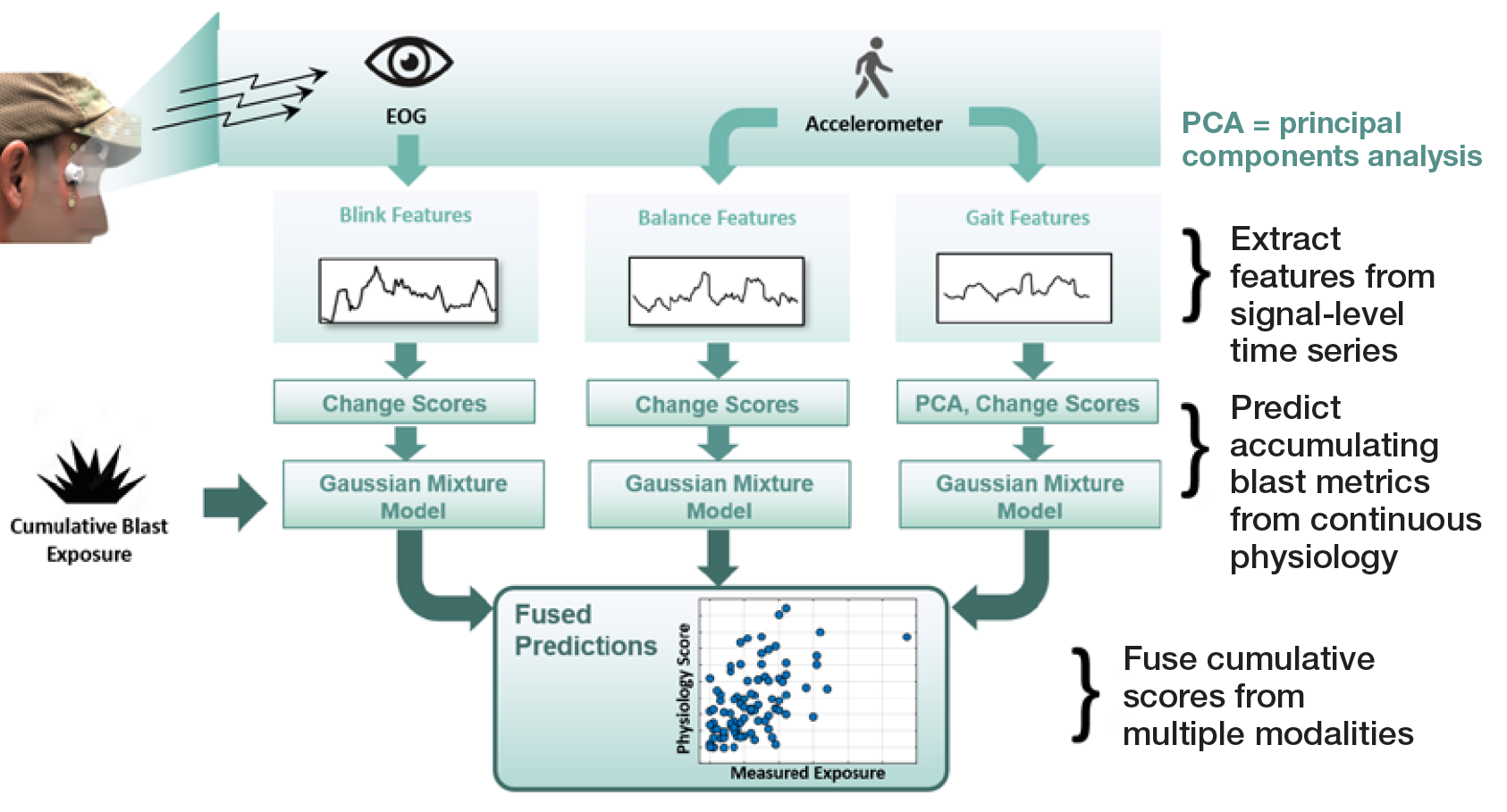Early Warning of Risk from Blast Exposure
MIT Lincoln Laboratory researchers developed an advancement over other technologies that predict an individual’s risk from exposure to a blast. The unique algorithms of the EYEBOOM (Electrooculography and Balance Blast Overpressure Monitoring) system correlate data from wearable sensors and blast-pressure measurements to gauge a person’s level of risk during and after an explosive event. An electrooculography (EOG) device affixed near the user’s eye senses eye and head movements and gait, collecting data indicative of physical and cognitive status. A shoulder-worn sensor measures blast pressure at the time of exposure. EYEBOOM’s combination of both physiological data and standard estimates of overpressure impact yields an improved, individualized analysis of exposure risk.

The EYEBOOM system coordinates data obtained from two body-worn sensors to calculate an individual’s risk of physical and cognitive impairment caused by exposure to explosive noise. The system can be adapted to relay results to a wireless device like a cellphone.
Background
Military, law enforcement, and construction personnel are routinely exposed to blast overpressure. The immediate impacts of these exposures often present no diagnosable physical injury; yet, over-exposure can lead not only to delayed ear/hearing damage but also to a decrease in cognitive abilities, such as memory, reaction times, and decision-making. Some over-exposed people have also exhibited depression or anxiety.
Improved Risk Analysis
The EYEBOOM system is designed to notify an individual of the risk from a blast exposure before symptoms are perceptible or become severe. Its real-time identification of risk promotes early interventions, such as modifications to a training or work routine, changes in protective gear, or medical assistance. EYEBOOM addresses the limitations of many existing wearable monitors—an inability to define occupational exposure limits, to gauge individual susceptibility to overpressure, and to account for personal contributory factors, such as fatigue or stamina.
The wearable EOG sensor continuously records the wearer’s head and eye movements and gait. Eye movements, such as blinks and rapid shifts in directional focus, can warn of cognitive strain. Data on gait help create a picture of the wearer’s physical status, for example, fatigue indicated by a slowing pace or unbalanced movements suggesting inner-ear damage. The shoulder-worn device measures the level of blast energy experienced by the wearer.
The physiological data logged by EOG and the overpressure benchmarks corresponding to the wearer’s exposure are input into our innovative algorithm to generate an individualized exposure risk. The novelty of our algorithm primarily lies in its detection of, and attention to, decreases in complex eye and body movements that may be signs that the brain is compensating for injury by functioning at an elementary level.

EYEBOOM combines continuous physiology and blast exposure monitoring in a lightweight machine learning framework. Changes in multiple physiological measures (i.e., scores) indicating the user’s responses to blast conditions are pre-processed and fused to generate robust features that are compared to accumulating blast metrics to identify potentially unsafe levels of exposure.
Benefits
- Continuously monitors physiological signals to assess risk not only from one high-level overpressure blast but also from cumulative exposure to low-level events, such as jackhammering or gunfire
- Provides real-time results for immediate modification of activities or preventive strategies
- Uses nonintrusive, on-body devices compatible with other equipment, such as a helmet or vest
- Works in remote, rugged, or difficult-to-navigate environments because the system needs no sophisticated support technology like video
Additional Resources
Patent Application WO2023278716A1
H.M. Rao et al., “Changes in Eye Tracking Features across Periods of Overpressure Exposure,” Military Medicine, vol. 188, no. 11−12, November/December 2023.
2024 R&D 100 Award Winner